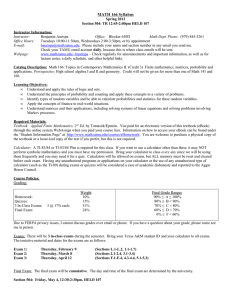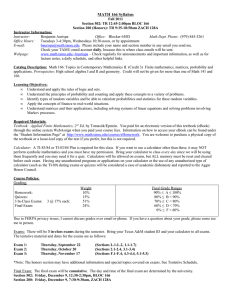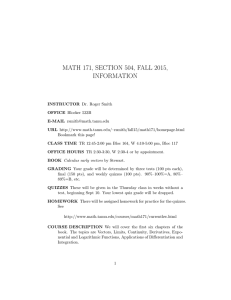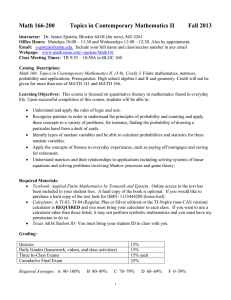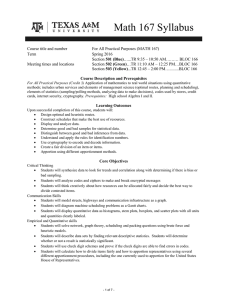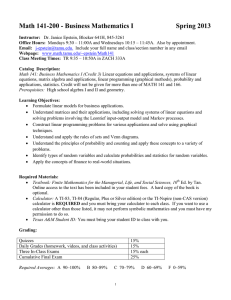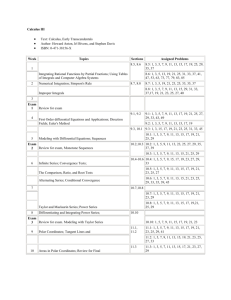Math 166 Syllabus
advertisement
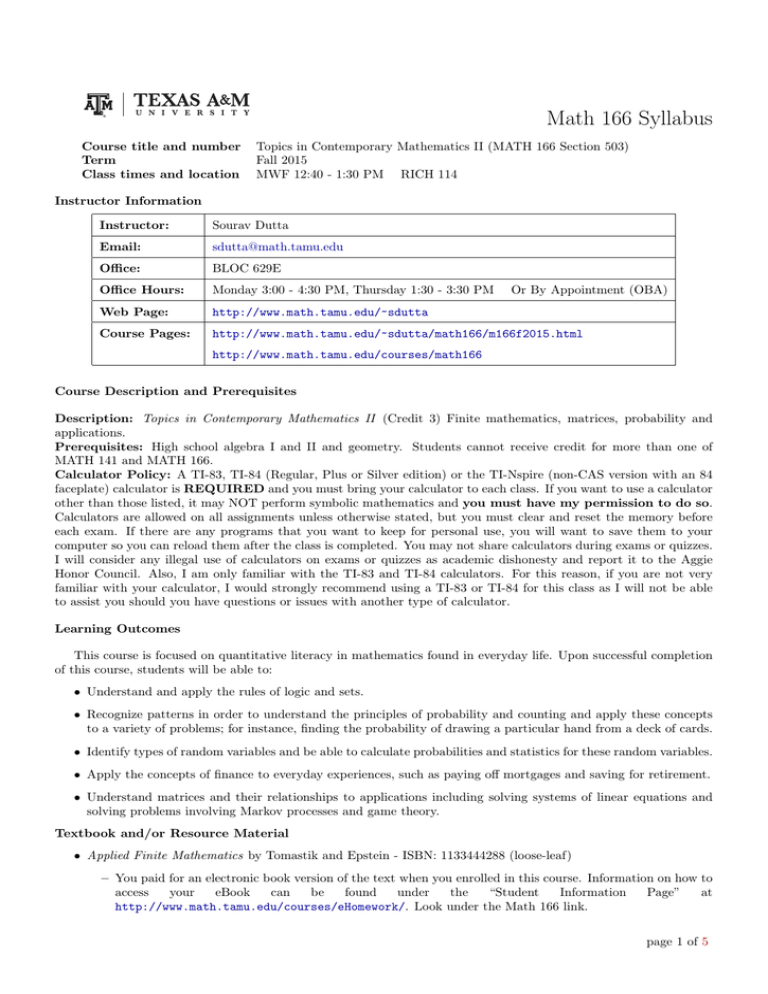
Math 166 Syllabus Course title and number Term Class times and location Topics in Contemporary Mathematics II (MATH 166 Section 503) Fall 2015 MWF 12:40 - 1:30 PM RICH 114 Instructor Information Instructor: Sourav Dutta Email: sdutta@math.tamu.edu Office: BLOC 629E Office Hours: Monday 3:00 - 4:30 PM, Thursday 1:30 - 3:30 PM Web Page: http://www.math.tamu.edu/~sdutta Course Pages: http://www.math.tamu.edu/~sdutta/math166/m166f2015.html Or By Appointment (OBA) http://www.math.tamu.edu/courses/math166 Course Description and Prerequisites Description: Topics in Contemporary Mathematics II (Credit 3) Finite mathematics, matrices, probability and applications. Prerequisites: High school algebra I and II and geometry. Students cannot receive credit for more than one of MATH 141 and MATH 166. Calculator Policy: A TI-83, TI-84 (Regular, Plus or Silver edition) or the TI-Nspire (non-CAS version with an 84 faceplate) calculator is REQUIRED and you must bring your calculator to each class. If you want to use a calculator other than those listed, it may NOT perform symbolic mathematics and you must have my permission to do so. Calculators are allowed on all assignments unless otherwise stated, but you must clear and reset the memory before each exam. If there are any programs that you want to keep for personal use, you will want to save them to your computer so you can reload them after the class is completed. You may not share calculators during exams or quizzes. I will consider any illegal use of calculators on exams or quizzes as academic dishonesty and report it to the Aggie Honor Council. Also, I am only familiar with the TI-83 and TI-84 calculators. For this reason, if you are not very familiar with your calculator, I would strongly recommend using a TI-83 or TI-84 for this class as I will not be able to assist you should you have questions or issues with another type of calculator. Learning Outcomes This course is focused on quantitative literacy in mathematics found in everyday life. Upon successful completion of this course, students will be able to: • Understand and apply the rules of logic and sets. • Recognize patterns in order to understand the principles of probability and counting and apply these concepts to a variety of problems; for instance, finding the probability of drawing a particular hand from a deck of cards. • Identify types of random variables and be able to calculate probabilities and statistics for these random variables. • Apply the concepts of finance to everyday experiences, such as paying off mortgages and saving for retirement. • Understand matrices and their relationships to applications including solving systems of linear equations and solving problems involving Markov processes and game theory. Textbook and/or Resource Material • Applied Finite Mathematics by Tomastik and Epstein - ISBN: 1133444288 (loose-leaf) – You paid for an electronic book version of the text when you enrolled in this course. Information on how to access your eBook can be found under the “Student Information Page” at http://www.math.tamu.edu/courses/eHomework/. Look under the Math 166 link. page 1 of 5 MATH 166 September 7, 2015 – If you would like a physical copy of the textbook you may buy one, but it is not required. • You must bring your Texas A&M student ID to each class and exam. Grading Policies The course grading will be based on the results of the following: • WebAssign Homework: All online homework problem sets will be based in the online system WebAssign. Everything you will need to know about logging into your account is available at http://www.math.tamu.edu/courses/eHomework/. Please visit this site for help with technical difficulties, announcements, and more information. I suggest you bookmark this page and visit it before you login to WebAssign each time. Be sure to start each assignment well in advance of the due date. If you ever have technical issues with WebAssign, please fill out a Student Help Request Form found at http://www.math.tamu.edu/courses/eHomework/. • Quizzes and In-Class Activities: You can expect to be given a mixture of in-class announced and unannounced quizzes throughout the semester. Quizzes may be given at any time during class, so make sure you arrive on time to each class and do not leave class early. Quizzes must be done completely on your own, unless otherwise noted. You may only use the resources listed in the directions of the individual quiz. You must show all of your work, including calculator methods, to obtain full credit. Additionally there will be very short in-class activities administered occasionally when I finish lecturing on specific topics. You will be required to work in groups of two for these in-class activities. • Exams: There will be three in-class exams. You will be expected to show all of your work, including calculator methods, on all problems for full credit, unless it is stated otherwise. • Final Exam: The in-class final exam is COMPREHENSIVE. • Grade Breakdown Activity Date Percentage Homework Weekly 10% Quizzes Weekly 15% In-class Activities Weekly 5% Exam I September 25 15% Exam II October 23 15% Exam III November 20 15% Final Exam December 14 25% 10:30 AM - 12:30 PM TOTAL 100% • Grading Scale Range Grade 90% ≤ average ≤ 100% A 80% ≤ average < 90% B 70% ≤ average < 80% C 60% ≤ average < 70% D 0% ≤ average < 60% F page 2 of 5 MATH 166 September 7, 2015 At the end of the semester you will receive the grade you earned according to the distribution above. Grades will occasionally be posted on eCampus (http://ecampus.tamu.edu). If you ever have any question about your current grade or wish to verify that our records match, you may set up an appointment with me. • Excused Absences: Attendance is essential and may be used in conjunction with your final exam grade as a consideration in the case of borderline grades. For excused absences please refer to Student Rule 7 at http://student-rules.tamu.edu/rule07. The Texas A&M University Explanatory Statement for Absence will NOT be accepted. Excuses for absences must be substantiated by appropriate documentation. Falsification of documentation is a violation of the Honor Code and it is my obligation to report all violations to the Honor Council. An absence for a non-acute medical service does not constitute an excused absence (i.e. routine doctor appointments etc.) Notification before the absence is required when possible (acknowledged email message is acceptable). Otherwise, you must notify me within 2 working days of the missed exam, quiz, or assignment to arrange a makeup. This notification should include an explanation of why notice could not be sent prior to the missed assignment. Further, an absence due to a non-acute medical service or appointment (such as a regular checkup) is not an excused absence. • Make-up exams will be only permitted due to official University excused absences and the next possible make-up time be chosen from http://www.math.tamu.edu/courses/makeupexams.html or according to my convenience. If you foresee the need to be absent during an exam, you must notify me in advance. Students with an official University excused absence are permitted to make up quizzes and other in-class assignments only for the dates of the absence and only for the dates specifically mentioned in the supporting documentation. Since the homework is done at your convenience, there will be no make-ups or extensions on homework. If there are any extenuating circumstances, please bring it to my attention immediately and within 2 working days of the due date for the missed homework. • Grade disputes: If you disagree with any deduction taken on an assignment or exam handed back in class, you must bring it to my attention within two working days of it being returned to be re-graded. You should retain all returned work through the end of the semester to compare the grade assigned to the grade recorded in eCampus. I cannot discuss grades via email or phone due to privacy issues. page 3 of 5 MATH 166 September 7, 2015 Course Topics (Tentative weekly schedule. All changes will be announced in class.) Week Topics Sections Covered 1 Logic, truth tables, sets Sections L.1-L.2, 1.1 2 Number of elements in a set, sample spaces and events, basics of probability Sections 1.1-1.4 3 Rules for probability, conditional probability, independent events Sections 1.4-1.6 4 Bayes’ Theorem. Review. Exam 1 (L.1-L.2, 1.1-1.7) Section 1.7 5 Multiplication Principle, permutations, combinations Sections 2.1-2.2 6 Probability applications of counting principles, Bernoulli trials, random Sections 2.3-2.4 variables 7 Random variables and histograms, measures of central tendency, measures Sections 3.1-3.3 of spread 8 The normal distribution, Review. Exam 2 (2.1-2.4, 3.1-3.4) Section 3.4 9 Simple and compound interest, annuities, sinking funds Sections F.1-F.3 10 Amortizations, introduction to systems, writing systems of linear equations, Sections F.4, 4.3-4.4 solving systems of linear equations with unique and non-unique solutions 11 Systems of linear equations with non-unique solutions, matrices, matrix Sections 4.4, 5.1-5.2 multiplication with applications 12 Inverse matrices, Review, Exam 3 (F.1-F.4, 4.3-4.4, 5.1-5.3) Section 5.3 13 Markov processes, regular Markov processes, Absorbing Markov processes Sections M.1-M.3 Game theory, Review for Final Exam Finish Chapter M 14/15 Sections G.1-G.2 Americans with Disabilities Act (ADA) The Americans with Disabilities Act (ADA) is a federal anti-discrimination statute that provides comprehensive civil rights protection for persons with disabilities. Among other things, this legislation requires that all students with disabilities be guaranteed a learning environment that provides for reasonable accommodation of their disabilities. If you believe you have a disability requiring an accommodation, please contact Disability Services, in Cain Hall, Room B118, or call 845-1637. For additional information visit http://disability.tamu.edu. Academic Integrity “An Aggie does not lie, cheat, or steal, or tolerate those who do.” Upon accepting admission to Texas A&M University, a student immediately assumes a commitment to uphold the Honor Code, to accept responsibility for learning, and to follow the philosophy and rules of the Honor System. Students will be required to state their commitment on examinations, research papers, and other academic work. Ignorance of the rules does not exclude any member of the TAMU community from the requirements or the processes of the Honor System. For additional information on the Honor Council Rules and Procedures, consult http://aggiehonor.tamu.edu. page 4 of 5 MATH 166 September 7, 2015 Sources of Help: 1. Office hours: I am here to help, but I won’t know if you have a question unless you ask! I encourage you to ask questions both in and out of class, come to office hours, and talk to me. The more you participate, practice, and attempt to understand, the more successful you will be. The scheduled office hours are listed at the beginning of the syllabus. 2. Help sessions: Help sessions are an opportunity for you to ask questions and get help with your homework. At a help session, students can come and ask questions to student help session leaders at their own convenience within the hours that the sessions run. For more information about the schedule of help sessions for this course, visit http://www.math.tamu.edu/courses/helpsessions.html. 3. Week-in-Review (WIR): There will be one Week-In-Review session held every week starting the second week of classes. Each review is open to all MATH 166 students. Week-in-Reviews are given by an instructor who reviews topics covered in class that week and reviews additional examples. For more information about the schedule of the Week in Reviews for this course, visit http://www.math.tamu.edu/courses/weekinreview.html. Additional sets of old Week-in-Review questions with solutions are linked from our course webpage. 4. Class Notes: An outline of notes will be posted before class each day. It will be beneficial to print these out and bring them with you to class. You should review your notes after class, and make sure to get any questions you have about the material in the notes answered, before the next class meeting, if possible. You should also review your notes when working on homework or when preparing for exams. 5. Your Classmates: Form study groups! Ask each other for assistance. Work together to understand the material. Note that, except in-class activities all other graded assignments, quizzes, homework and exams are to be done individually unless otherwise stated. 6. Practice: It is essential that you practice as many problems as you can. In addition to the quizzes, in-class activities, and WebAssign homework, there are suggested homework problems. Other Important Dates: September 4 is the last day for adding/dropping a course. November 20 is the last day to drop a course with no penalty (Q drop). For additional important dates, visit http://registrar.tamu.edu/ general/calendar.aspx. Email Etiquette: All email communication should have a brief topic and the following information in the subject line - “< your name (UIN) >, MATH 166:503”. I might miss the emails that are sent without the subject containing these details. My email address is sdutta@math.tamu.edu. Please check your University email address regularly for course related announcements which will usually be also posted on the course webpage and on eCampus. Classroom Etiquette: During class I will stay focused on teaching you mathematics, so please stay focused on learning the mathematics being taught. This means you should stay awake throughout the class, you should not be reading a newspaper or materials from another course, you should refrain from discussion not related to class and you should not leave class early unless you have cleared it with me first. If I feel you are being disruptive or disrespectful during class, you may be asked to leave. No unapproved electronic devices are allowed in the classroom. You may use electronic devices like tablets for taking notes, only after my approval. If you wish to take notes on devices with bigger screens like laptops, you might consider sitting towards the back of the classroom to avoid causing any distraction for your fellow students. Cell phones and all other unapproved electronic devices must be kept in silent mode and put away while you are in the classroom. If I hear your cell phone ringing during class, I may ask you to leave the classroom and you will therefore not be able to complete any in-class assignments. Copyright Policy: All printed materials disseminated in class or on the web are protected by Copyright laws. One copy (or download from the web) is allowed for personal use. Multiple copies or sale of any of these materials is strictly prohibited. No exams or assignments may be shared with anyone outside of the class or posted on any website. page 5 of 5
